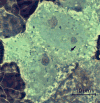Laboratory maintenance of Rickettsia rickettsii
- PMID: 19016440
- PMCID: PMC2725428
- DOI: 10.1002/9780471729259.mc03a05s11
Laboratory maintenance of Rickettsia rickettsii
Abstract
This unit includes protocols for the laboratory maintenance of the obligate intracellular bacterium Rickettsia rickettsii, including propagation in mammalian cell cultures, as well as isolation, counting, and storage procedures. Regulations for working with R. rickettsii in biosafety level 3 containment are also discussed.
Figures





Similar articles
-
Listeria monocytogenes: cultivation and laboratory maintenance.Curr Protoc Microbiol. 2013 Nov 5;31:9B.2.1-9B.2.7. doi: 10.1002/9780471729259.mc09b02s31. Curr Protoc Microbiol. 2013. PMID: 24510292 Free PMC article.
-
Isolation of Rickettsia rickettsii and Rickettsia bellii in cell culture from the tick Amblyomma aureolatum in Brazil.Ann N Y Acad Sci. 2006 Oct;1078:523-9. doi: 10.1196/annals.1374.103. Ann N Y Acad Sci. 2006. PMID: 17114770
-
Infection of human vascular endothelial cells by Rickettsia rickettsii.J Infect Dis. 1984 Feb;149(2):201-6. doi: 10.1093/infdis/149.2.201. J Infect Dis. 1984. PMID: 6421942
-
Laboratory diagnosis of rickettsial diseases.Clin Dermatol. 1996 May-Jun;14(3):301-6. doi: 10.1016/0738-081x(96)00016-8. Clin Dermatol. 1996. PMID: 8727134 Review. No abstract available.
-
Developmental sequence and surface membrane assembly of rickettsiae.Annu Rev Microbiol. 1985;39:69-88. doi: 10.1146/annurev.mi.39.100185.000441. Annu Rev Microbiol. 1985. PMID: 3933409 Review. No abstract available.
Cited by
-
Evaluating the Clinical and Immune Responses to Spotted Fever Rickettsioses in the Guinea Pig-Tick-Rickettsia System.Curr Protoc. 2022 Nov;2(11):e584. doi: 10.1002/cpz1.584. Curr Protoc. 2022. PMID: 36383032 Free PMC article.
-
The rickettsial OmpB β-peptide of Rickettsia conorii is sufficient to facilitate factor H-mediated serum resistance.Infect Immun. 2012 Aug;80(8):2735-43. doi: 10.1128/IAI.00349-12. Epub 2012 May 21. Infect Immun. 2012. PMID: 22615250 Free PMC article.
-
Isolation of Rickettsia rickettsii in Rocky Mountain Spotted Fever Outbreak, Panama.Emerg Infect Dis. 2021 Apr;27(4):1245-1247. doi: 10.3201/eid2704.201606. Emerg Infect Dis. 2021. PMID: 33755006 Free PMC article.
-
Identification of novel surface-exposed proteins of Rickettsia rickettsii by affinity purification and proteomics.PLoS One. 2014 Jun 20;9(6):e100253. doi: 10.1371/journal.pone.0100253. eCollection 2014. PLoS One. 2014. PMID: 24950252 Free PMC article.
-
GFPuv-Expressing Recombinant Rickettsia typhi: a Useful Tool for the Study of Pathogenesis and CD8+ T Cell Immunology in R. typhi Infection.Infect Immun. 2017 May 23;85(6):e00156-17. doi: 10.1128/IAI.00156-17. Print 2017 Jun. Infect Immun. 2017. PMID: 28289147 Free PMC article.
References
Literature Cited
-
- Dumler JS, Walker DH. Rocky Mountain spotted fever changing ecology and persisting virulence. New Engl J Med. 2005;353:551–3. - PubMed
-
- Giemsa G. Eine vereinfachung und vervollkommnung meiner methylenazur-methylenblau-eosin-farbemethode zur erzielung der Romanowsky-Nocht’schen chromatinfarbung. Zentabl Bakteriol Parasitenkd Infectkrankh. 1904;37:308.
-
- Giménez DF. Staining rickettsiae in yolk-sac cultures. Stain Technol. 1964;39:135–140. - PubMed
Key References
-
- Weiss E, Coolbaugh JC, Williams JC. Separation of viable Rickettsia typhi from yolk sac and L cell host components by Renografin density gradient centrifugation. Appl Microbiol. 1975;30:456–463. This is the seminal article describing the use of a Renografin density gradient for the isolation of pure, viable rickettsiae. - PMC - PubMed
-
- Kimman TG, Smit E, Klein MR. Evidence-based biosafety: a review of the principles and effectiveness of micrbiological containment measures. Clin Microbiol Rev. 2008;21:403–425. The review article discusses the principles and methods of biosafety regulations as determined by the NIH, the CDC, the WHO and the European Union. - PMC - PubMed
MeSH terms
Grants and funding
LinkOut - more resources
Full Text Sources

